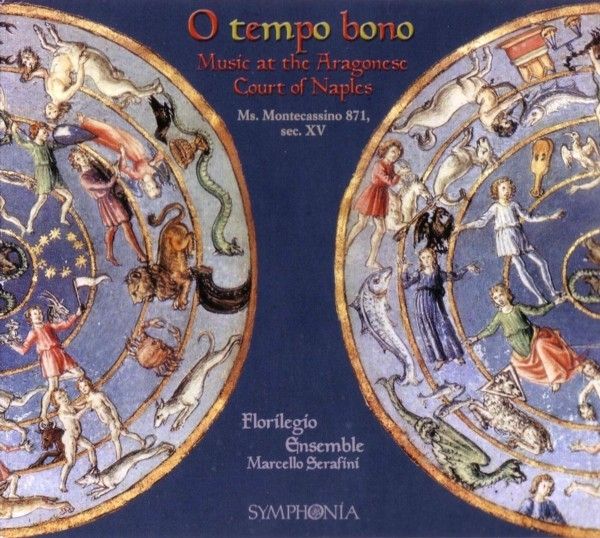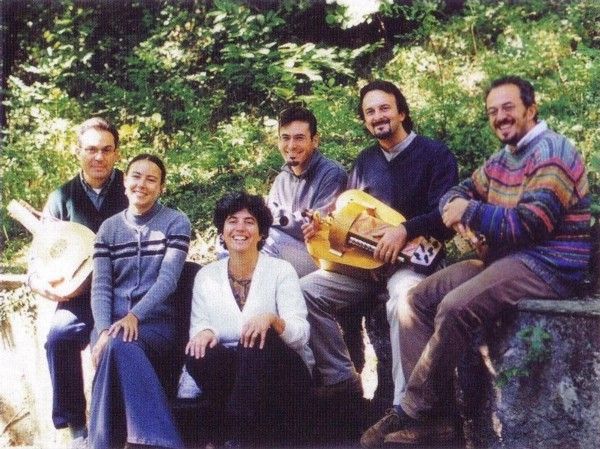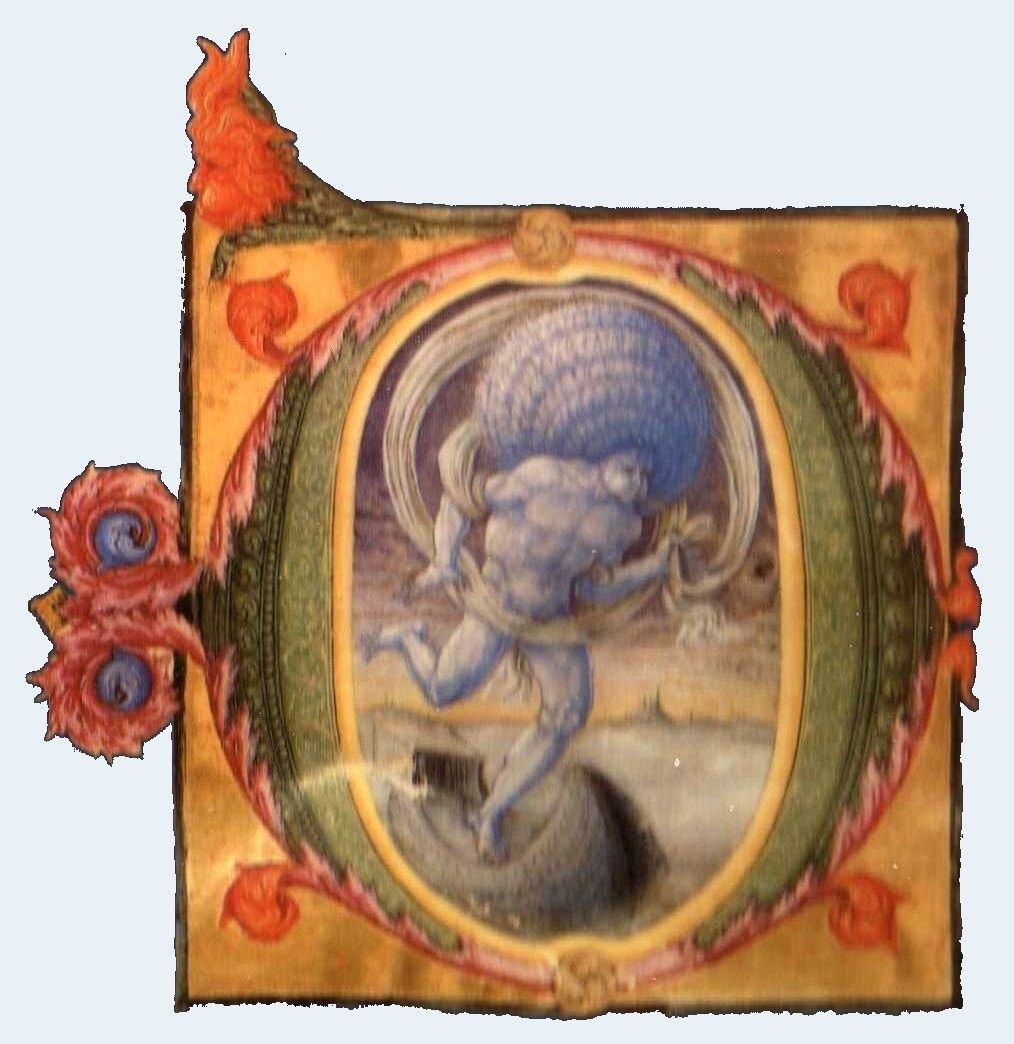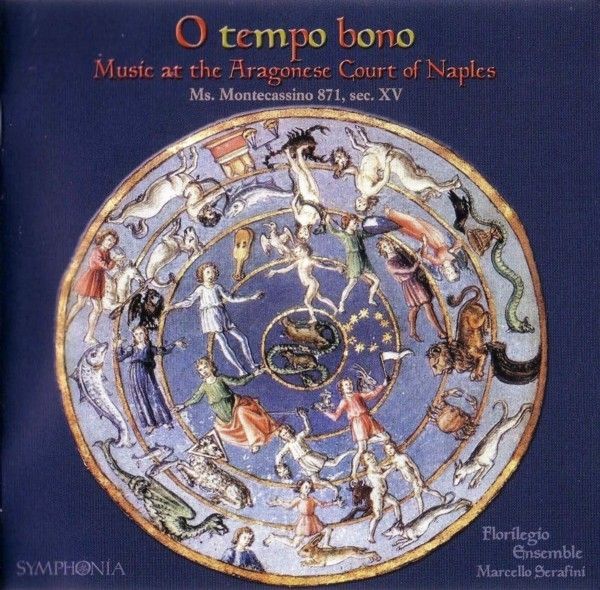O Tempo Bono / Florilegio Ensemble
Music at the Aragonese Court of Naples · Ms Montecassino 871, sec. XV

medieval.org
Symphonia 00180
Registrazione: settembre 2000,
Oratorio della Beata Vergine, Castello
Cabiaglio, Varese
Tecnica : SYMPHONIA, Pugnano, Pisa
Presa del Suono: Roberto Meo
Direttore Artistica: Sigrid Lee
Montaggio Digitale: Sigrid Lee
Produzione: Roberto Meo, Sigrid Lee
01 - Adoramus te Domine [5:23]
02 - Alle stamegne [1:59]
03 - Fortuna tort (strum.) [2:12]
04 - O pellegrina, o luce [5:09]
05 - A Florence (strum.) [2:49]
06 - Johannes OCKEGHEM. Petite camusette [5:34]
07 - O tempo bono [2:52]
08 - La vida de Colin [2:16]
09 - Walter FRYE. Suis aprentis (strum.)
[2:59]
10 - Guillaume DUFAY. Par le regart [6:21]
11 - Johannes CORNAGO. Morte mercé [3:16]
12 - Mon fort souspirz (strum.) [2:03]
13 - John BEDINGHAM. Gentil madonna [4:27]
14 - Voca la galiera [2:06]
15 - Guillaume DUFAY. Adieu m'amour (strum.)
[2:22]
16 - John BEDINGHAM. Fortuna las (strum.)
[3:23]
17 - Pere ORIOLA. O vos homines [6:21]
Florilegio ensemble
Marcello Serafini
Anita Camarella, voce
Maria Consigli, voce
Antonio Serafini, liuto, cornamusa
Alberto Crugnola, liuto, ghironda, voce
Marcello Serafini, viella, ribeca, chitarra rinascimentale, voce
Isacco Colombo, ciaramelle, flauti, flauto e tamburino, tamorra
Alta Capella
Isacco Colombo, ciaramella
Alberto Ponchio, bombarda
Daniele Bicego, tromba a tiro

[... I
manoscritti hanno vite segrete, delle quali possiamo cogliere qualche
barlume dalle tracce lasciate su di essi da antichi possessori, la
maggior parte dei quali non lasciarono altra notizia di sé, o
dai vagabondaggi che li portarono ad approdare ai porti più
inattesi...]
Dietro a un manoscritto c'è il
fascino della storia e di una storia, ed il valore di un lavoro. Ognuno
era veramente importante, perché non era oggetto di scambio e di
commercio, ma la testimonianza, spesso unica, di un "messaggio" che non
doveva perdersi nell'inaffidabilità delle parole. La fatica
della compilazione, gratificata dal signum manos, è pari
a quella della conservazione nel tempo, e quest'ultima ci permette di
rivolgerci al passato con inconfutabili elementi.
Nell'aprire un manoscritto ci sentiamo
immersi in un'altra realtà e ripercorriamo un tragitto
lunghissimo, fino al segreto del "principio", restando, allo stesso
tempo, disarmati ma incuriositi.
Il "Montecassino 871" redatto nel XV
secolo, al quale dedichiamo il nostro primo lavoro discografico, ci ha
da subito affascinati per la varietà di stili compositivi
contenuti, ma soprattutto per la presenza, purtroppo limitata, di
alcuni brani che testimoniano una cultura musicale italiana ancora viva
anche se tenuta in ombra dalla scienza degli "oltremontani". La
necessita di riportare alla luce questo patrimonio artistico poco
conosciuto ci ha indotti a concentrare il nostro studio a questo secolo
"misterioso", analizzando in modo integrale i manoscritti, e proponendo
una sintesi che possa dare un'idea degli enormi cambiamenti musicali
che avvennero nel '400. Conservato presso l'abbazia benedettina di
Montecassino in Frosinone, il MS fu compilato intorno agli anni '70 del
XV secolo presso la corte aragonese a Napoli. Conserva brani sacri e
profani, alternati fra loro senza un ordine logico.La copiatura
dell'intero MS si pensa sia durata dieci anni ed è stata
eseguita da un solo scrittore. I brani contenuti presentano stili e
forme diverse; di fianco a musiche di scuola fiamminga, caratterizzate
da una scrittura fittamente contrappuntistica ed imitativa e con
sezioni melismatiche soprattutto nella voce di superius, ne compaiono
altre di carattere più accordale ed omoritmico, con un
linguaggio tonale, tipici della musica profana italiana degli ultimi
anni del XV secolo. Vi sono anche composizioni costruite su terni
popolari.
Solo alcuni nomi compaiono nel MS, tra
cui J. Cornago, che sappiamo attivo presso la corte napoletana ed
è l'autore di "Morte mercè" . Il brano è
costituito da due sezioni distinte sia nella musica che nel testo. Una
prima parte, dall'andamento accordale e incisivo è contrapposta
alla seconda più lirica e melismatica.
Il testo dello strambotto "O tempo
bono" di F. Galeota, anch'egli operante alla corta aragonese,
riporta un linguaggio dialettale tipico della poesia popolare italiana
della fine del '400. La musica rispetta i canoni dello strambotto;
andamento omoritmico, note ribattute, scarsa estensione vocale.
"Gentil madonna" è fra
le più belle composizioni dell'intero MS, ed era senz'altro moho
conosciuta al suo tempo viste le numerose concordanze. La ricostruzione
del testo, operata dal musicologo Nino Pirrotta, ci ha permesso di
"salvare" il brano proponendolo, nella registrazione, con due
formazioni musicali distinte; "alta cappella" e la "bassa cappella". La
prima esalta l'espressione armonica e il sapiente linguaggio
contrappuntistico, attraverso un impasto sonoro molto suggestivo, la
seconda restituisce al brano quel valore intimo sottolineato, oltre che
dalla liricità del canto, dal significato testuale.
"Suis aprentis" è in
realtà "So ys emprentid" del compositore inglese Walter
Frye. Nel Montecassino il brano si presente con il solo incipit
testuale, in una forma evidentemente corrotta, più alcune
interpolazioni frammentarie in francese. Evidentemente il compilatore
aveva poca dimestichezza con la lingua inglese; ciò non ha
impedito che il brano venisse inscrito nel MS, forse in virtù
del favore di cui esso godeva; d'altra parte ciò pone
l'attenzione sull'aspetto prettamente musicale del brano a scapito di
quello testuale, almeno nel contesto della compilazione del
Montecassino e ne invita quindi una esecuzione strumentale.
"A Florence la ioyose cite"
è una composizione che prende spunto dalla melodia popolare "La
fille Guillemin" riproponendola quasi fedelmente nella voce di tenor.
Questa melodia compare anche nel trattato sulla danza di D. da Piacenza
del XV secolo, ma sicuramente era in voga già dal secolo
precedente. E' costituita da quattro diverse sezioni: Quaternaria-bassa
danza-quaternaria-piva. Noi abbiamo mantenuto questa caratteristica
anche nella esecuzione polifonica.
Una nota negativa del Montecassino
è l'assenza o l'incompletezza dei testi che, grazie alle
concordanze musicali (come l'Escorial IV a 24) e letterali (Paris
f.it.1035) trovano la loro integrità. Secondo lo schema del
sonetto toscano, S. Ferrari riesce a ricostruire il testo di "O
pellegrina o luce". L'ambivalenza del significato della parola
"pellegrina", come di anima smarrita dall'amore, o di anima in cerca di
salvezza, viene messa in risalto da un discorso musicale meditativo e
raccolto, quasi fosse una preghiera.
La cospicua presenza di composizioni
di autori fiamminghi nei MSS del '400 testimonia come la cultura di
quest'ultimi si era espansa in tutta Europa. "Petite camusete" e
"Par le regart de vos beaulx yeulx" ne sono un piccolo esempio.
Il primo è costruito su una melodia affidata al "tenor" dal
carattere fortemente popolare, che ripropone una felice scena d'amore
tra Robin e Marion, protagonisti della omonima commedia di A. de la
Halle. Contemporaneamente il testo del "superius" narra di un amore
sofferto e non restituito e vede in Robin e Marion la speranza di una
felice risoluzione. Il riferimento alla cormmedia di A. de la Halle ci
ha suggerito una interpretazione di carattere più arcaico.
Le innumerevoli concordanze
(più di dieci) di "Par le regart de vos beaulx yeulx"
testimoniano la fama che godette il brano ai suoi tempi. Nella nostra
versione abbiamo sovrapposto all'originale le diminuzioni organistiche
prese dal "Buxheimer Orgelbuch". Come è risaputo, sono poche le
composizioni strumentali del '400 se si escludono i brani riportati nei
trattati di danza. Fonti letterarie e iconografiche ci forniscono,
però, gli indizi di una fiorente pratica strumentale del
repertorio vocale.
Le versioni per due liuti di "Fortuna
tort" e "Adieu m'amour" vogliono sottolineare la nascente
necessità espressiva che da li a pochi decenni sarebbe sfociata
in una maggiore individualità del singolo strumento o in
formazioni "cameristiche", una delle quali poteva essere costituita da
una viella, due liuti e un flauto, come in "Mon fort souspirz".
I tre brani "Alle stamegne", "La
vida de Colin" e "Voca la galiera" hanno in comune quel
carattere popolare tipico della musica italiana della seconda meta del
'400. Il primo è il richiamo di uno stamegnatore in una piazza
di paese... le donne sono invitate a setacciare la farina! Il secondo
rievoca un tale "Colin" o "Colinet", indefinibile membro di una
famiglia di giullari e musicisti attivi nel corso del XV secolo. Lo
scioglilingua potrebbe rievocare il suono degli strumenti di questi
esecutori, cosi come il loro stato di ebbrezza; in "Voca la galiera"
l'incipit testuale viene ripetuto per tutto il brano altrimenti privo
di testo: l'andamento omoritmico può così ricordare il
ritmo di una "canzone di lavoro" densamente "ante litteram".
In "O vos homines" le struggenti rime
amorose del poeta per Lucrezia d'Alagna sono interpolate ed amplificate
da frammenti dell'altrettanto struggente testo delle lamentazioni di
Geramia del Sabato Santo. La musica sembra un intreccio fra stile sacro
e profano, con note lunghe e movimenti per terze.
L'antifona "Adoramus te domine"
è riferita all'adorazione della croce: abbiamo voluto immaginare
una scena di devozione popolare di un avvenimento liturgico, e quindi
abbiamo utilizzato strumenti comuni nella musica popolare anche di
allora.
MARCELLO SERAFINI

[... Manuscripts have secret lives. We can catch only a glimpse of the
traces left by their previous owners, most of whom have provided no
information about themselves, or of the wanderings that took them to
unexpected places.]
Behind every manuscript there is the fascination of its place in
history and its individual story, and the importance of the work
itself. Each work was truly significant, because it was not a
commercial bartering object, but evidence, and often the only evidence
of a "message" that should not get lost in the untrustworthiness of the
spoken word. The enormous effort of copying and compiling has its
necessary counterpart in the task of conserving the manuscript over
time, thus permitting us to regard the past with irrefutable elements.
In opening a manuscript we are immersed in another world and we retrace
its long and winding path, leading to the secret of its beginning. We
are enchanted and curious.
The manuscript Montecassino 871, compiled in the late 15th century, and
to which we have dedicated our first recording, captured our attention
immediately for its rich variety of compositional styles, but most of
all because of the presence, (unfortunately limited), of a few pieces
bearing witness to an Italian musical culture that was still alive
though overshadowed by the learned Northern European music. The
importance of bringing this little known artistic patrimony to light
induced us to concentrate our studies on this "mysterious" century,
analyzing its manuscripts and proposing a synthesis that could give an
idea of the enormous musical changes that came about in the 15th
century.
The manuscript resides in the Benedictine monastery of Montecassino in
Frosinone. It was compiled around the 1470's at the Aragonese court of
Naples and contains both sacred and secular music, mixed in no logical
order. The copying of the manuscript was undertaken within a ten year
period and was carried out by one single scribe.
The pieces offered here represent different forms and styles. Alongside
music of the Flemish school, characterized by thickly contrapuntal and
imitative writing with melismatic passages primarily in the superius,
or highest voice, we find others with a more chordal and homorhythmic
character, with the tonal language typical of Italian secular music of
the late 15th century. There are also some compositions written on
popular melodies.
Only a few names appear in the manuscript, among them J. Cornago who we
know was active at the Neapolitan court. He is the composer of Morte
mercè. The piece consists of two distinct sections regarding
both the music and the text. The first part is incisive and chordal
whereas the second is more lyrical and melismatic.
The text of the strambotto, O Tempo Bono is by F.
Galeota, also active at the Aragonese court It is written in dialect
which was typical of late 15th century popular Italian poetry. The
music follows the rules of a strambotto: homorhythmic movement,
repeated notes, and limited vocal range.
Gentil madonna is one of the most beautiful compositions of the
entire manuscript and was undoubtedly very well known at that time,
given its high number of concordances (over ten). The reconstruction of
the text by musicologist Nino Pirotta has enabled us to "salvage" the
piece, presenting it in two different contexts: the alta cappella
(loud consort)and the bassa cappella (soft consort). The first
puts the harmonic expression and refined contrapuntal language into
relief, whereas the second gives back to the piece its more intimate
character, underlined both by the lyricism of the singing and its
meaning of its poetry.
Suis aprentis is actually "So ys emprentid" by the English
composer Walter Frye. In Montecassino the piece is present with only an
incipit of the text in a clearly corrupt form followed by some
fragmentary interpolations in French. Clearly the copyist was not very
familiar with the English language. This did not prevent the
composition from being included in the manuscript, perhaps because of
its popularity. On the other hand we are forced to look at the musical
angle of the piece in the context of Montecassino, at any rate, and so
we have opted for an instrumental performance.
A Florence la ioyose cité (In Florence, the joyous city)
takes its idea from the folk tune "La fille Guillemin" which appears
virtually unchanged in the tenor. The melody appears as well in the
15th century dance treatise by Domenico da Piacenza but was most
certainly already in vogue at the end of the preceding century. There
are four sections to the dance: Quaternaria-bassa
danza-quaternaria-piva. We have maintained this structure for our
polyphonic performance.
One negative factor of the Montecassino manuscript is that so many of
the texts are either incomplete or absent altogether. Thanks to musical
concordances (for example Escorial IV.a.24) and literary ones (Paris
f.it. 1035) many of them can be reconstructed. According to the scheme
of the Tuscan sonnet, S. Ferrari has been able to reconstruct the text
of O pellegrina luce. The ambivalence of the meaning of the
word "pellegrina" (pilgrim or wayfarer) as a soul lost by love, or a
soul seeking salvation is put into relief by its meditative and
introspective, almost prayer-like character.
The conspicuous presence of Franco-flemish composers in 15th century
manuscripts bears witness to the spread of their culture in all of
Europe. Petite camusete by Ockeghem and Par le regart de
vos beaulx yeulx by Dufay are examples. The first is constructed on
a popular sounding melody in the tenor recounting a happy love scene
between Robin and Marion, the main characters of a 13th century play by
Adam de la Halle. At the same time the text in the superius tells of
the pains of unrequited love and sees in Robin and Marion the hope of a
happy ending. The ancient story suggested to us the use of a
particularly archaic arrangement.
The countless concordances (more than 10) for Par le regart de vos
beaulx yeulx are evidence of the fame enjoyed by the piece at that
time. In our version we have superimposed the organ diminutions from
the Buxheimer Orgelbuch on the original composition.
As is well known, the number of explicitely instrumental compositons in
the 15th century is rather small if we exclude the pieces contained in
dance treatises. Literary and iconographical sources have given us
signs as to the flourishing fashion of instrumental performance based
on vocal repertoire. Fortuna tort and Adieu m'amour
have been arranged for two lutes, and Mon fort souspirz for
recorder, two lutes and vielle.
There are three pieces on this recording having in common a particular
rustic flavor, typical of Italian music in the second half of the 15th
century. Alle stamegne is the cry of a miller in the village
piazza. The women are called to sift the flour! La vida de Colin
is the tale of a certain "Colin" or Colinet" who could have been a
member of a family of minstrels and musicians active during the 15th
century. The tongue twister of a text might evoke the sounds of the
instruments of these players as well as their state of drunkenness. In Voca
la galiera we have repeated the incipit throughout the piece
otherwise lacking in text. The homorhythmic movement could be
reminiscent of a work song decidedly "ante litteram".
The tormented love verses of O vos homines written for Lucrezia
d'Alagna are interpolated with and amplified by fragments of an equally
tormented text from the Lamentations of Jeremiah used for the
Holy Saturday liturgy. The music weaves in and out between sacred and
secular, with long notes and harmony in thirds.
The antiphon Adoramus te domine refers to the adoration of the
cross. We have imagined a scene evoking the gathering of the populace
for a devotional liturgical event. We have used instruments common to
the traditional music of the time.
MARCELLO SERAFINI
Translation: Sigrid Lee




